The shoulder is a ball and socket joint. The ball portion of the joint is called the humeral head, and is part of the humerus (upper arm bone). The socket portion is called the glenoid, and is part of the scapula (shoulder blade). The humeral head (ball) fits into the glenoid (socket) and the two bones rub together as the shoulder moves.
Ball and Socket Of Healthy Shoulder Joint Surfaces
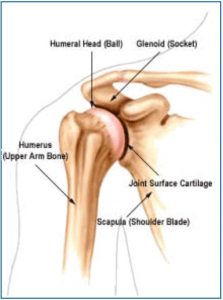
In a healthy shoulder joint, the surfaces of these bones where the ball and socket rub together are very smooth and covered with a tough protective tissue called cartilage. Arthritis causes damage to the bone surfaces and cartilage. These damaged surfaces eventually become painful as they rub together.
Arthritic Shoulder Joint Surfaces
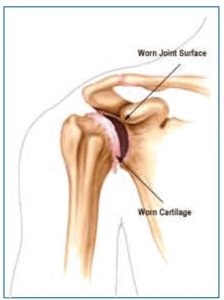
There are many ways to treat the pain caused by arthritis. One way is total shoulder replacement surgery. The decision to have total shoulder replacement surgery should be made very carefully after consulting your doctor and learning as much as you can about the shoulder joint, arthritis, and the surgery. In total shoulder replacement surgery, the ball and socket that have been damaged by arthritis are removed and replaced with artificial parts made of metal and a very durable plastic material. We call these artificial parts “implants.” These implants are shaped so that the shoulder joint will move in a way that is very similar to the way the joint moved when it was healthy.
What to Bring to the Hospital
Below is a list of things you may want to bring with you to the hospital in preparation for your surgery. Talk with your physician as he/she may have additional information about preparing for your hospital stay.
- Your personal belongings should be left in the car until after surgery. Tell your family that your room will be assigned when you are in surgery or in recovery, at which point they can bring your personal items to your room.
- Personal grooming items that you may want to pack include a toothbrush, toothpaste, hairbrush, eyeglasses/contacts, comb, deodorant, shaving cream/electric razor, shampoo, lotion, undergarments, and a robe.
- Bring slippers or flat rubber-soled shoes for walking in the hallways.
- Bring loose fitting clothing for your trip home.
- Bring any medications you are currently taking. You should also write down your medication information to be given to the hospital staff. Be sure to include the name, strength, and how often you take the medications. Please communicate any allergies you might have to your doctors and the nursing staff.
- If you use a breathing exerciser (IBE), be sure to bring it with you from home, as you will probably need this right after surgery. Leave jewelry, credit cards, car and house keys, checkbooks, and items of personal value at home. Bring only enough pocket money for items such as newspapers, magazines, etc.
Getting to the Joint
The patient is first taken into the operating room and positioned on a special operating table as though lounging in a beach chair. The arm is placed on a board that will allow the surgeon to move it up or down as necessary during the surgery. Anesthesia is given and, when it has taken effect, the skin around the shoulder and upper arm is thoroughly scrubbed and sterilized with an antiseptic liquid.
An incision about six inches long is then made over the shoulder joint. The incision is gradually made deeper through muscle and other tissue until the bones of the shoulder joint are exposed.
Shoulder Joint Exposed
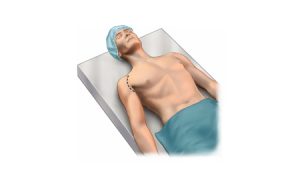
Replacing the Socket Portion of the Joint
The implant that replaces the socket consists of a durable plastic insert with a very smooth, cupped surface.
Implant to Replace Socket in Shoulder Blade
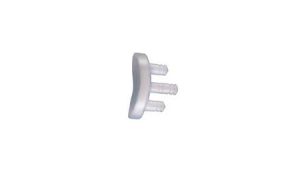
Removing the Surface of the Socket
The arm is maneuvered until the humeral head is dislocated from the socket.
Special precision instruments are then used to remove the damaged cartilage and bone surface from the glenoid, and to shape the socket so it will match the shape of the implant that will be inserted. Holes are then drilled into the socket to accommodate the fixation pegs on the implant. These pegs help stabilize the implant.
Socket Prepared for Implant
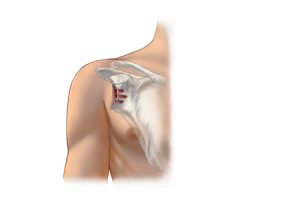
Inserting the Implant
The socket implant is attached by using a special kind of cement for bones. The cement is pressed into the holes. The implant is then inserted.
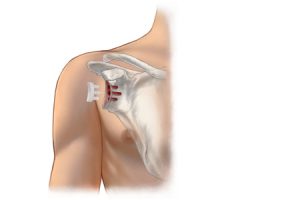
Replacing the Ball Portion of the Joint
The implant that replaces the ball consists of a long metal stem that fits down into the humerus. A metal head in the shape of a partial sphere is mounted on top of this stem. This head contacts the socket implant in the shoulder blade.
Metal implant to replace ball portion of shoulder joint
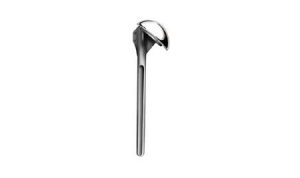
Preparing the Humeral Canal
The upper arm bone has relatively soft, porous bone tissue in the center. This part of the bone is called the “canal.”
Special instruments are used to clear some of this soft bone from the canal.
Using a precision guide and saw, the damaged rounded portion (ball) of the humerus is removed.
Humeral Head (Ball) is Removed
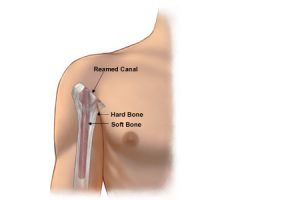
Inserting the Implant
The metal stem implant may be held in place by either using the special bone cement, or by making it fit very tightly in the canal. The surgeon will choose the best method, depending on the patient’s age and expected activity level.
If cement is used, it is injected into the canal first, and then the implant is inserted into the canal. If cement is not used, the implant is simply inserted into the canal.
On some implants, the stem and partial sphere are one piece. On others, they may be two separate pieces. If the partial sphere is a separate piece, it is usually secured to the top of the stem after the stem has been inserted.
Stem Implant with Partial Sphere (Head)
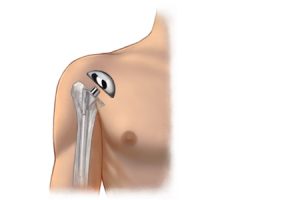
Shoulder Implants After Insertion
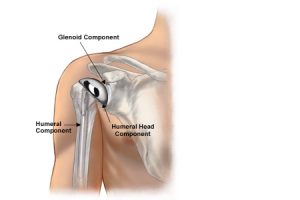
Closing the Wound
When all the implants are in place, the surgeon places the new ball that is now part of the upper arm bone into the new socket that is part of the shoulder blade. If necessary, the surgeon may adjust the ligaments that surround the shoulder to achieve the best possible shoulder function.
When the ligaments are properly adjusted, the surgeon sews the layers of tissue back into their proper position. A plastic tube may be inserted into the wound to allow liquids to drain from the site during the first few hours after surgery. After the tube is inserted, the edges of the skin are sewn together, and a sterile bandage is applied to the shoulder. Then, the patient is taken to the recovery room.
For more information about shoulder replacements, please refer to the Guide to Shoulders.
 ">
">
Get In Touche
Contact OrthoBethesda Today!
Whether you’ve received a referral from your primary care physician or would like to visit our premier team to discuss any orthopedic issues you may be experiencing, we invite you to contact us today. Patients in Bethesda, MD, Arlington, VA, and beyond can give us a call at (301) 530-1010.
